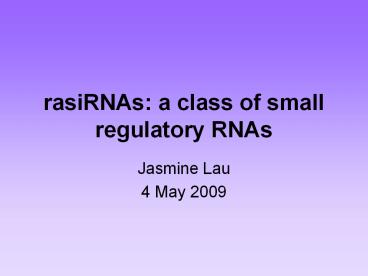rasiRNAs: a class of small regulatory RNAs - PowerPoint PPT Presentation
Title:
rasiRNAs: a class of small regulatory RNAs
Description:
Nicotiana and Arabidopsis thaliana plants 24-26 nucleotide long endogenous siRNA ... Gene silencing and establishing heterochromatin Dicer cleaves long ... – PowerPoint PPT presentation
Number of Views:285
Avg rating:3.0/5.0
Title: rasiRNAs: a class of small regulatory RNAs
1
rasiRNAs a class of small regulatory RNAs
- Jasmine Lau
- 4 May 2009
2
The Family of small RNAs
Small noncoding regulatory RNAs
Longer length 24-27 nucleotides
Shorter length 20-25 nucleotides
piwi-interacting RNAs (piRNAs)
small interfering RNAs (siRNAs)
microRNAs (miRNAs)
Other piRNAs
rasiRNAs
rasiRNAs Repeat-associated small interfering
RNAs
? sequence-specific gene silencing (RNAi
mechanism)
? forms RNA-protein complexes with Piwi subfamily
proteins
? sequences correspond to genomic repeats and
transposons
3
First hints of rasiRNAs
2001
- Trypanosoma brucei
- parasitic protist species
- causes African trypanosomiasis (sleeping
sickness)
2002
- Abundant 24-26 nucleotide long siRNA-like RNAs
- Represented 2 retrotransposons in the genome
- Both sense and antisense polarity
2003
2004
Regulatory mechanism to silence retrotransposon
transcription and mobilization?
2005
2006
2007
2008
Present
http//www.sanger.ac.uk/Projects/T_brucei/Tryp.car
toon.shtml
4
First hints of rasiRNAs
- Trypanosoma brucei
- parasitic protist species
- causes African trypanosomiasis (sleeping
sickness)
2001
2002
- Abundant 24-26 nucleotide long siRNA-like RNAs
- Represented 2 retrotransposons in the genome
- Both sense and antisense polarity
2003
2004
Regulatory mechanism to silence retrotransposon
transcription and mobilization?
2005
Nicotiana and Arabidopsis thaliana plants
2006
- 24-26 nucleotide long endogenous siRNA species
- Represented 2 retrotransposons in Nicotiana
genome, - 1 retrotransposon in Arabidopsis genome
- Both sense and antisense polarity
2007
2008
Linked to DNA methylation and systemic silencing
Mechanism to keep retrotransposon silent?
Present
5
rasiRNAs new class of RNAs
2001
Drosophila melanogaster small RNA profiling
- 2 distinct classes of small RNAs
- 21-23 nt RNAs
- 24-26 nt RNAs
2002
2003
Sequences correspond to genomic repeats or
transposons
2004
Sequences correspond to genomic
repeats/transposons ? Class of RNAs called
repeat-associated siRNAs (rasiRNAs)
2005
Also described in zebrafish, fission yeast
2006
- Sense antisense orientation of repetitive
sequence elements - Long Terminal Repeat (LTR) and non-LTR
retrotransposons - DNA transposons
- Satellite and microsatellite sequences
- Complex repeats
2007
2008
Present
6
rasiRNAs subclass of piRNAs
2001
Longer length 24-27 nucleotides
2002
2003
piwi-interacting RNAs (piRNAs)
2004
- 24-26 nucleotide long RNAs
- BUT lack transposon or repetitive seqeuences
2005
Other piRNAs
rasiRNAs
2006
2007
2008
Present
7
rasiRNA biogenesis
Argonaute protein family
Piwi subfamily
Ago subfamily
Ago1
Ago2
Ago3
Aubergine (Aub)
Piwi
Associate with miRNAs
Associate with siRNAs
Associate with rasiRNAs, present in germline
cells and early embryos
Dicer-dependent production to produce
double-stranded precursor
Dicer-independent production
8
rasiRNA biogenesis
AGO3
Adenine at nucleotide 10
Sense transcript
3
5
10 complementary nucleotides
Antisense transcript
3
5
Uridine at 5 terminal end
PIWI/ AUB
Zucchini/ squash?
2-O-Me
AGO3
?
AGO3
3
5
5
3
Pimet
AGO3
5
3
3
5
5
5
3
3
PIWI/ AUB
2-O-Me
Pimet
3
5
5
3
?
PIWI/ AUB
PIWI/ AUB
Zucchini/ squash?
9
What do rasiRNAs do?
Present in fission yeast, plants, fly,
zebrafish Functions mainly in the germline and
early embryo development in fly and zebrafish,
found at very low levels in the adult fly.
Maintaining genomic stability
- Silencing and suppressing mobilization of
retrotransposons and other selfish genetic
transposable elements - Guide transcriptional and post-transcriptional
gene silencing of repetitive sequence elements - Guide chromatin silencing to establish and
maintain heterochromatin
- Also in particular for flies
- Maintaining germ cell self-renewal
- Establishing axis polarity of the early embryo
- Regulating pole cell formation and oocyte
maturation - Maintaining telomeres
10
How rasiRNAs work
Fission yeast Gene silencing and establishing
heterochromatin
Transcriptional silencing complex in nucleus ?
Ago1, Chp1 and Tas3
Binds DNA/ chromatin, induce DNA and histone
methylation
Dicer cleaves long dsRNA
Plants Similar mechanism to yeast (above),
also repress repetitive transposable elements
Induce systemic gene silencing, Histone H3
lysine-9 methylation, DNA methylation ? Direct
chromatin modifications
Ago4-dependent mechanisms
11
How rasiRNAs work
Drosophila melanogaster
Induce histone H3 Lysine 9 methylation and
association of HP1 chromatin binding protein with
heterochromatin
rasiRNAs associate with piwi Argonaute proteins,
and RNA helicases (Spindle-E and Armitage)
Downstream effector mechanisms and pathways are
not yet known ? Literature between piRNAs and
rasiRNAs are merging
12
Summary rasiRNAs
rasiRNAs Repeat-associated small interfering
RNAs
Longer length 24-27 nucleotides
? sequence-specific gene silencing (RNAi
mechanism)
piwi-interacting RNAs (piRNAs)
? forms RNA-protein complexes with Piwi subfamily
proteins
Other piRNAs
rasiRNAs
? sequences correspond to genomic repeats and
transposons

